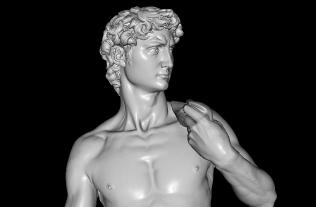
The models of Michelangelo's David we used for ScanView were created as part of The Digital Michelangelo Project. The David was first scanned using a laser rangefinding scanner set to quarter-millimeter resolution. The range data created by the scanner was then aligned using software written for the project. The difficulty of keeping our large scanner calibrated in the field led to systematic warping of our range data, as described in our Siggraph 2000 paper. Aligning warped range data has proven to be a hard problem, as described in a pair of papers to appear in Proc. 3DIM '03. Click here and here for links to these papers. As a result, the highest resolution reconstruction of the sculpture we have currently is accurate to only two millimeters. Some topological problems do exist on our current model. Some of these were created by our volumetric hole filling software, which we used to close the model in areas where no scan data was acquired (usually deep crevices and other hard-to-reach areas).
In our current setup, the rendering server will render a 1.25 million polygon model of the David when the viewer is positioned relatively far from the surface of the model. When the zooming in close to the surface, a 7.2 million polygon model that is accurate to two millimeters is rendered. The 7.2 million polygon model was simplified to create the 1.25 million polygon model using an out of core simplification algorithm developed by Cignoni, Rocchini, Montoni, and Scopigno.
For more information about our scans of the David, look here for information about our model of David's head, and here for some color renderings.